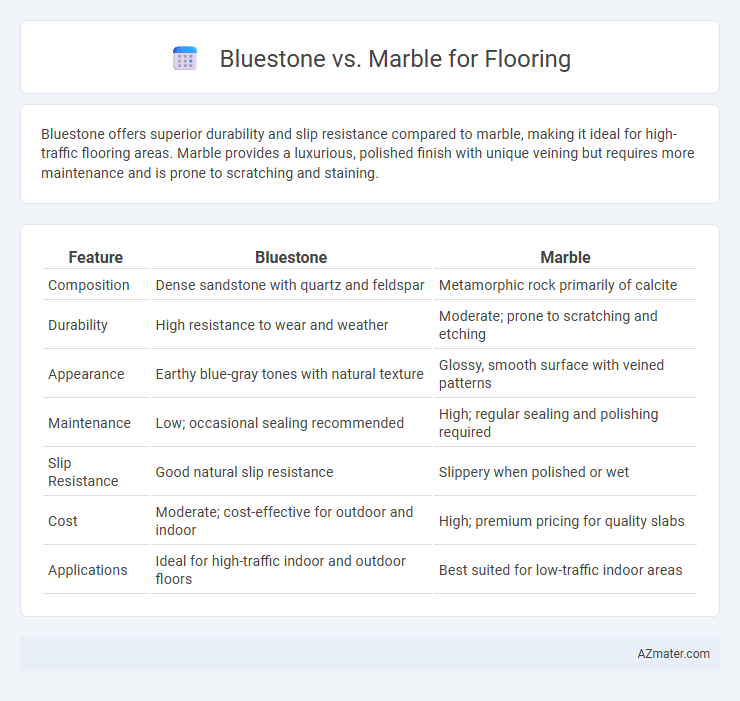Bluestone offers superior durability and slip resistance compared to marble, making it ideal for high-traffic flooring areas. Marble provides a luxurious, polished finish with unique veining but requires more maintenance and is prone to scratching and staining.
Table of Comparison
| Feature | Bluestone | Marble |
|---|---|---|
| Composition | Dense sandstone with quartz and feldspar | Metamorphic rock primarily of calcite |
| Durability | High resistance to wear and weather | Moderate; prone to scratching and etching |
| Appearance | Earthy blue-gray tones with natural texture | Glossy, smooth surface with veined patterns |
| Maintenance | Low; occasional sealing recommended | High; regular sealing and polishing required |
| Slip Resistance | Good natural slip resistance | Slippery when polished or wet |
| Cost | Moderate; cost-effective for outdoor and indoor | High; premium pricing for quality slabs |
| Applications | Ideal for high-traffic indoor and outdoor floors | Best suited for low-traffic indoor areas |
Introduction to Bluestone and Marble Flooring
Bluestone flooring, a dense, durable natural stone with a distinctive blue-gray hue, offers excellent slip resistance and weather durability, making it ideal for outdoor and high-traffic indoor areas. Marble flooring, prized for its elegant veining and polished finish, provides a luxurious, timeless appeal suited for sophisticated interior spaces but requires more maintenance due to its porous nature. Both materials present unique aesthetic and functional benefits, with bluestone favored for rugged durability and marble celebrated for refined beauty.
Key Differences Between Bluestone and Marble
Bluestone, a dense sandstone, offers exceptional durability and slip resistance, making it ideal for outdoor flooring, while marble, a metamorphic carbonate rock, provides a luxurious, polished appearance preferred for indoor spaces. Bluestone typically displays earthy blue-grey tones with a textured surface, contrasting with marble's smooth, veined patterns and a wider color range including white, black, and green hues. Maintenance requirements differ as bluestone is less prone to staining and etching, whereas marble demands regular sealing and careful cleaning to preserve its glossy finish.
Aesthetic Appeal: Bluestone vs Marble
Bluestone offers a natural, earthy aesthetic with its subtle variations in blue-gray tones and textured surface, creating a rustic yet elegant appearance in flooring. Marble provides a more polished and luxurious look characterized by smooth surfaces and distinctive veining patterns that enhance sophistication and brightness. Choosing between bluestone and marble depends on the desired style, with bluestone favoring organic, matte finishes and marble emphasizing classic, glossy elegance.
Durability and Longevity Comparison
Bluestone offers exceptional durability with its dense composition, making it highly resistant to chipping, cracking, and weathering, ideal for high-traffic areas. Marble, while renowned for its elegance and unique veining, is softer and more prone to scratches and etching from acidic substances, requiring more maintenance to preserve its appearance. Over time, bluestone's toughness ensures longer-lasting performance and minimal wear, whereas marble may show signs of aging faster, impacting its longevity in flooring applications.
Cost Analysis: Bluestone vs Marble
Bluestone flooring costs typically range from $8 to $15 per square foot, making it a more budget-friendly option compared to marble, which can cost between $10 and $30 per square foot depending on quality and origin. Installation expenses for both materials vary, with marble demanding higher skilled labor, increasing its overall cost. Maintenance for marble involves more frequent sealing and polishing, adding to long-term expenses, whereas bluestone requires less intensive upkeep.
Installation Process and Considerations
Bluestone flooring installation typically involves mortar bed application and careful leveling due to its dense, natural stone composition, requiring skilled labor for a durable finish. Marble, being softer and more prone to scratching, demands precise handling, a cement backer board, and sealing after installation to prevent stains and damage. Both materials require professional expertise, but bluestone's weight and irregular surface increase installation complexity compared to the smoother, more uniform marble slabs.
Maintenance and Care Requirements
Bluestone flooring requires minimal maintenance due to its dense composition, resisting stains and scratches better than marble, which is more porous and susceptible to etching from acidic substances. Regular sealing of marble floors is necessary to prevent discoloration and damage, while bluestone benefits from less frequent sealing, making it more convenient for high-traffic areas. Both materials need gentle cleaning with pH-neutral products to preserve their natural appearance and longevity.
Slip Resistance and Safety Factors
Bluestone offers superior slip resistance compared to marble due to its textured surface, making it a safer choice for flooring in high-traffic or wet areas. Marble's polished finish, while visually appealing, tends to be more slippery and may increase the risk of falls. Prioritizing slip resistance and safety, bluestone is often recommended for outdoor and commercial flooring applications where traction is critical.
Eco-Friendliness and Sustainability
Bluestone flooring offers superior eco-friendliness due to its natural abundance and minimal processing requirements, resulting in a lower carbon footprint compared to marble. Marble extraction and finishing involve energy-intensive quarrying and chemical treatments, raising concerns about sustainability. Bluestone's durability and recyclability further enhance its role as a sustainable flooring option in environmentally conscious construction.
Which Flooring is Best for Your Space?
Bluestone flooring offers exceptional durability and slip resistance, making it ideal for high-traffic areas and outdoor spaces, while marble provides a luxurious, polished appearance suitable for formal interiors and low-traffic zones. Bluestone's natural variations and earthy tones complement modern and rustic designs, whereas marble's elegant veining and smooth texture elevate classic and contemporary aesthetics. Choosing the best flooring depends on your space's functional demands and stylistic preferences, balancing marble's maintenance needs against bluestone's resilience.

Infographic: Bluestone vs Marble for Flooring
 azmater.com
azmater.com